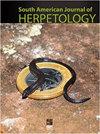Testudines、Crocodylia和Aves腹膜管的地形关系:进化意义
IF 0.7
4区 生物学
Q4 ZOOLOGY
引用次数: 1
摘要
摘要对Testudines、Crocodylia和Aves等物种的泄殖腔和腹膜管进行了分析,目的是鉴定和描述它们的形态,并研究它们与其他泄殖腔结构的可能关系。通过解剖和常规组织学准备进行研究。泄殖腔位于盆腔中,在Testudines和Crocodylia之间有所不同。在前者中,泄殖腔被分为三个隔间——粪腔、尿腔和前腔——没有褶皱将它们分开。相反,在Crocodylia中,粪足、尿足和前足被离散的褶皱,即粪足和尿足褶皱分开。腹膜的内脏层形成腹膜管,Testudines和Crocodylia也不同。在前者中,腹膜管的颅骨开口位于泌尿生殖窦的外侧,腹膜管向尾部伸入阴茎,然后是射精沟,直到器官的尾端。在Crocodylia中,腹膜管的颅骨开口位于粪管外侧,腹膜管向尾部延伸,直到到达阴茎体的乳头,并在那里终止。组织学上,腹膜管的间皮有一个简单的路面外观。在Testudines中,发现了具有简单立方上皮的区域,表明细胞活性强烈。固有层的特征是结缔组织增厚,中等密度,厚度可变,有一层排列在不同方向的平滑肌束。在Caiman yacare中,在涉及腹膜管的松散结缔组织上发现了成束的横纹肌。泄殖腔液和腹膜液具有很强的蛋白质相似性。腹膜管反映了与生殖相关的功能特征。在鸟类身上没有发现腹膜管。本文章由计算机程序翻译,如有差异,请以英文原文为准。
Topographic Relationships of the Peritoneal Canal of Testudines, Crocodylia, and Aves: Evolutionary Implications
Abstract. Cloacae and peritoneal canals of species of Testudines, Crocodylia, and Aves were analyzed with the purpose of identifying and describing their morphology and investigating their possible relationship with other cloacal structures. Studies were conducted from dissections and routine histological preparations. The cloaca is located in the pelvic cavity and differs between Testudines and Crocodylia. In the former, the cloaca is divided into three compartments—the coprodeum, urodeum, and proctodeum—without folds separating them. In contrast, in Crocodylia the coprodeum, urodeum, and proctodeum are separated by discrete folds, the coprourodeal and uroproctodeal folds. The visceral layer of the peritoneum forms the peritoneal canal and also differs in Testudines and Crocodylia. In the former, the cranial opening of the peritoneal canal is lateral to the urogenital sinus and the canal is caudally projected into the phallus, laterally followed by the ejaculatory groove until the caudal end of the organ. In Crocodylia, the cranial opening of the peritoneal canal is lateral to the coprodeum and the canal extends caudally until reaching a papilla in the body of the phallus, where it terminates. Histologically, the mesothelium of the peritoneal canal has a simple pavement appearance. In Testudines, regions with a simple cubic epithelium were found, indicating intense cell activity. The lamina propria is characterized by a thickening of the connective tissue, moderately dense with a variable thickness and with a layer of bundles of smooth muscle arranged in different directions. In Caiman yacare, bundles of striated skeletal muscles were found on the loose connective tissue that involves the peritoneal canal. The cloacal and peritoneal fluids have a strong protein similarity. The peritoneal canal reflects functional characteristics related to reproduction. No peritoneal canals were found in birds.
求助全文
通过发布文献求助,成功后即可免费获取论文全文。
去求助
来源期刊
CiteScore
1.50
自引率
0.00%
发文量
10
期刊介绍:
The South American Journal of Herpetology (SAJH) is an international journal published by the Brazilian Society of Herpetology that aims to provide an effective medium of communication for the international herpetological community. SAJH publishes peer-reviewed original contributions on all subjects related to the biology of amphibians and reptiles, including descriptive, comparative, inferential, and experimental studies and taxa from anywhere in the world, as well as theoretical studies that explore principles and methods.

 求助内容:
求助内容: 应助结果提醒方式:
应助结果提醒方式:


